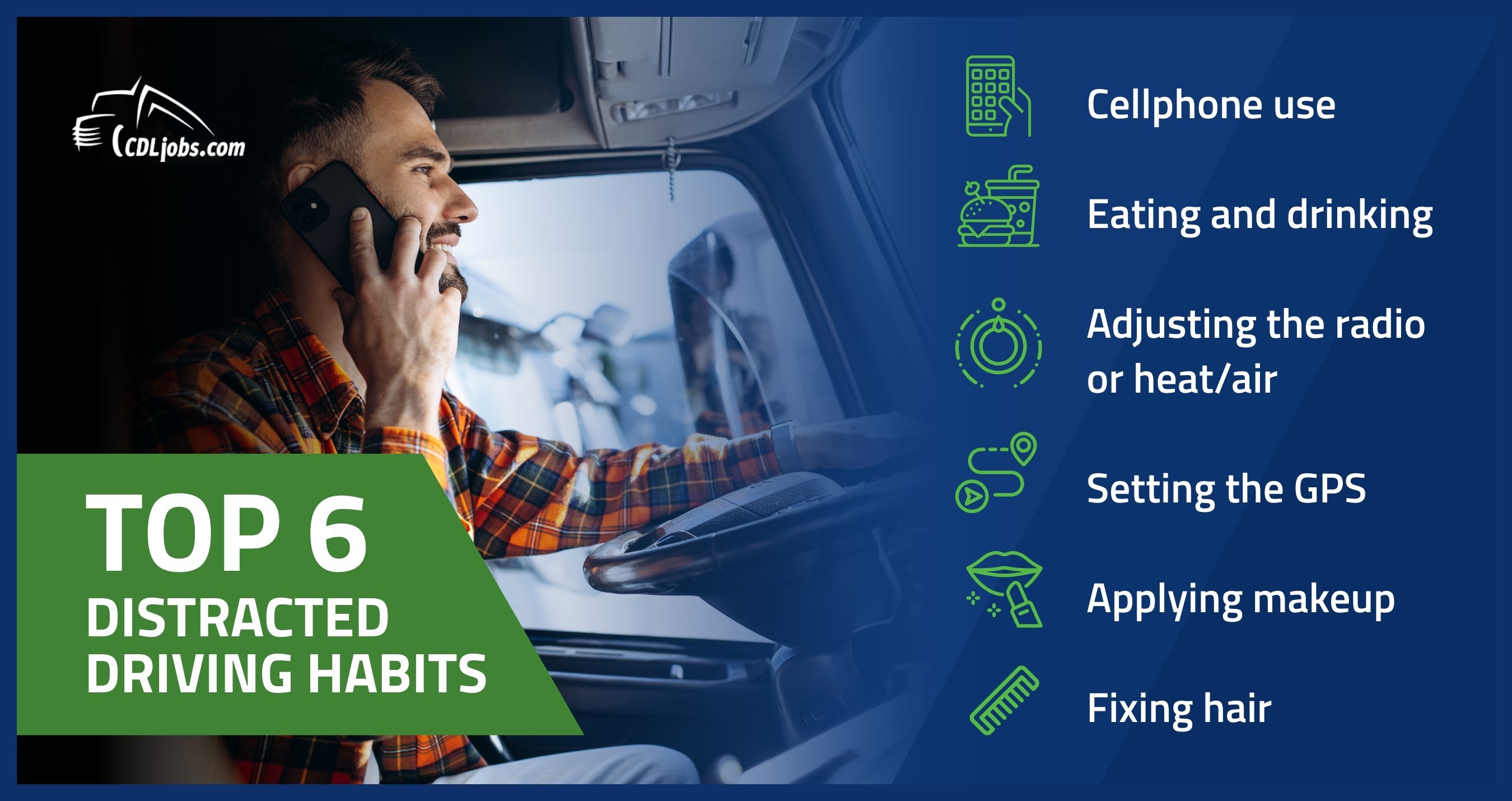With unlimited access to smartphones and other handheld devices, there’s always a temptation to take your eyes off the road. Many drivers don’t realize the harm in looking away to check a text message or making a phone call. However, holding your phone isn’t only dangerous—it’s also illegal.
Read on to learn more about the dangers of phone use while driving and other dangerous habits that can cause an accident
The Dangers of Distracted Driving
The National Safety Council presents a sobering statistic: at least eight people die daily from distracted driving. Although phone usage is the most common form of distracted driving, there are other behaviors you should avoid while operating a vehicle. Additional examples of activities that can pose a risk while driving include:
- Eating and drinking
- Adjusting the radio
- Setting the GPS
- Applying makeup
- Fixing hair

In 2021, distracted driving accidents resulted in 3,522 fatalities, according to the National Highway Traffic Safety Administration. Moreover, at least 8 percent of all fatal crashes have involved one or more distracted drivers. The nation's Secretary of Transportation Pete Buttigieg calls these statistics a "national crisis." Distracted driving can include people of all age groups and experiences. However, drivers between 16 and 24 have the highest rate of distracted driving citations.
What is Being Done About Distracted Driving Dangers?
As of March 2023, the Governors Highway Safety Association reports that 31 states and the District of Columbia have entirely banned the use of hand-held electronic devices while driving. This trend is being hailed as “hands-free” driving. Additionally, 47 states and D.C. have completely banned texting while driving. In Nebraska, the act of texting behind the wheel is a secondary offense, charged only with another moving violation. Missouri and Montana are the only states that currently do not prohibit texting while driving.
Some local municipalities have gone as far as to prohibit even talking on a cell phone while driving. This is largely due to the cognitive distraction that results in drivers sometimes swaying from their lane. All of these state laws apply to professional truck drivers as well. At the state level, these are considered to be among the top most stringent laws against texting while driving.
- Oregon: $1,000 fine - 10 times the average of other states but no license points are incurred
- Utah: $750 fine for the first offense and 50 points added to your license; if 200 points accrue, your license will be suspended.
- Illinois: $75 fine with escalating fees for subsequent violations. Considered a "moving violation," Illinois authorities will tack on 20 to 30 demerit points and may suspend your license if 3 moving violations occur in a year.
- Wisconsin: Four demerit points and a hefty fine up to $400 plus costs
High Cost of Distracted Driving for Truck Drivers
Distracted driving is more than dangerous for others on the road—the act can prove financially costly. As part of Distracted Driving Awareness Month, agencies have created a campaign called “U Drive. U Text. U Pay.” The ads under the campaign are meant to remind all, including truck drivers, of the financial repercussions of using your phone while on the road. As a professional driver, you should also remember your career is at risk when violating distracted driving laws.
In addition to state repurcussions, the fines and penalties currently reported by the Federal Motor Carrier Safety Administration include the following:
- Drivers face a penalty of up to $2,750 for distracted driving offenses. Employers also face fines if they permit their drivers to use handheld devices. Companies may have to pay a maximum of $11,000 per violation.
- Multiple distracted driving convictions may result in the truck driver losing their CDL. In some states, a distracted driving conviction could cause a 120-day suspension of a CDL license.
- Violations will also directly affect Safety Measurement System (SMS) results. When truck drivers disobey distracted driving laws, SMS results will get impacted negatively.
Types of Distracted Driving
Distracted driving behaviors typically fall into three categories: visual, cognitive, and manual. Each type will steal your focus away from the road. Drivers should be proactive in not engaging in activities that put them and others at risk. Although most state laws prohibit texting and using a handheld device while driving, you should still be mindful of other distractions.
Visual distractions include texting, adjusting the car radio, reaching down to grab something from the truck floor, and programming the GPS. Visual distractions take your eyes off the road, allowing plenty of time for accidents. You may miss a traffic light or stop sign within seconds. You could also fail to see a pedestrian or animal in your path.
Cognitive distractions refer to when drivers may still look at the road, but their minds are elsewhere. Fatigue or daydreaming could result in them not fully being aware of what’s happening in front of them. You may drift into the wrong lane or go through stop signs and traffic lights without stopping. Rear-end crashes could also occur when you’re distracted.
Manual distractions involve taking one or both hands off the wheel to perform an activity. Common manual distractions are eating, drinking, seat adjustment, and smoking. Manual distractions increase your accident risk by as much as 800 percent. You can end up crashing into another vehicle, striking a pedestrian, or veering off the roadway.
Surveyed Drivers Continue to Participate in Distracted Driving
Despite the risks, many drivers admit to some form of distracted driving. For example, over half of all drivers surveyed reported eating or drinking while operating a vehicle. Also, 36 percent admitted to using a cell phone at some point while they were driving. Young adults have a higher rate of cell phone usage while operating a car. The CDC reported that 39 percent of all high school drivers texted or emailed at least once over the last 30 days. Ages 18 to 24 reported feeling more pressure to respond to a text while driving than drivers aged 25 and older.
All drivers are starting to realize the consequences of distracted driving. Getting pulled over while using a cell phone could lead to a fine and points added to a driving record. In 2021 alone, the California Highway Patrol issued nearly 56,000 citations for distracted driving.
Tips to Avoid Distracted Driving
Truck drivers often feel physically and emotionally distant from loved ones while on the road. They may want to connect as often as possible, even when calling or texting someone back is unsafe. To limit cell phone usage, stick to the following:
- Make an emergency-only phone policy. Even though you could talk hands-free with Bluetooth devices, you may not be able to concentrate fully on your driving. You should even stow away your phone to keep it out of your mind.
- Schedule set call times. CDL drivers can set aside time daily to make and receive calls while parked or on a break.
- Consider blocking calls or texts temporarily. Adjust phone settings to driving mode. The phone can stop texts or calls from connecting while travelling in a motor vehicle.



